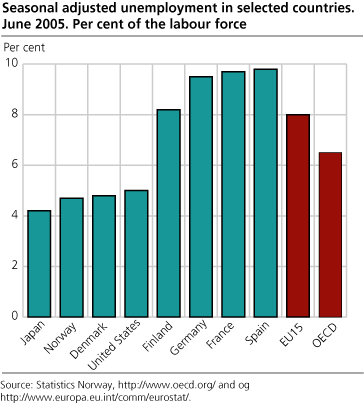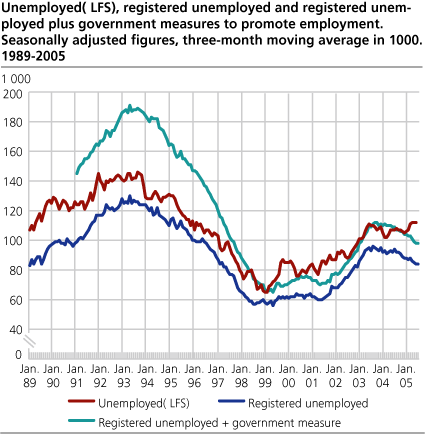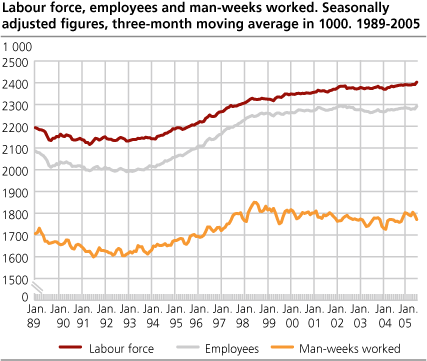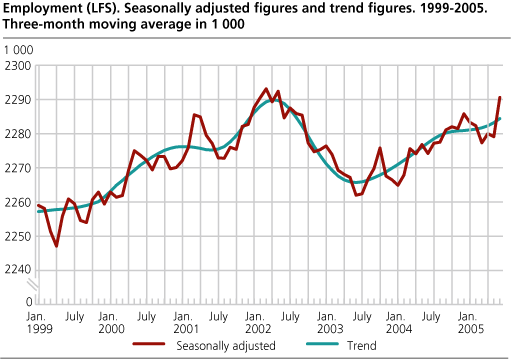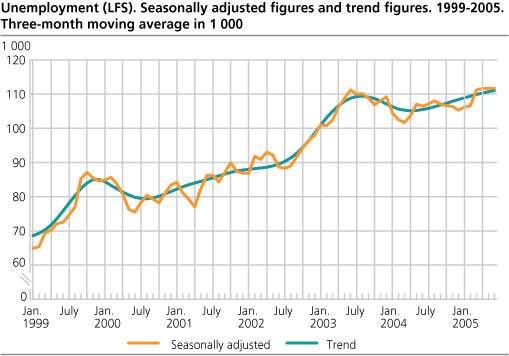Content
Published:
This is an archived release.
Unemployment unchanged
Unemployment in June stayed unchanged from the previous month. The figures presented in this article are adjusted for seasonal variations.
Unemployment in June (the May-July period) stayed unchanged from the previous month. Since March (February-April), there has been no change in these figures. Seasonally adjusted figures of registered unemployment at job centres show a decline of 4 000 people in the same period. When adding government measures to promote employment, the decrease amount to 5 000.
Fall in unemployment internationally
The seasonally adjusted unemployment rate for Norway was 4.7 per cent in June 2005, unchanged from March. The rate in the EU area fell from 8.1 to 8.0 per cent, while the OECD area saw the rate fall from 6.7 to 6.5 per cent. In the same period, the unemployment rate fell from 5.2 to 5.0 per cent in the USA, from 4.9 to 4.8 per cent in Denmark, from 8.5 to 8.2 per cent in Finland, from 9.8 to 9.7 per cent in France, and from 9.7 to 9.5 per cent in Germany, according to figures from the OECD and Eurostat .
Following a period of negative development from the spring of 2002 to the summer of 2003, employment showed a more or less continuous rise until the end of 2004. From March to June, there was no significant increase in the number of employees. Still, the June figure strengthens the impression of ongoing growth.
Man-weeks worked showed a downward trend between June 1998 and May 2003. Since then, we have seen signs of an increasing trend in these figures. Still, from March to June, man-weeks worked decreased by 18 000, which is on level with the LFS error margin.
Uncertain figures
Quality tests show that the seasonally adjusted LFS unemployment figures are uncertain. The seasonal-adjustment method has problems identifying a stable seasonal pattern for this series. The random component is relatively large compared with the seasonal component. The figures should therefore be treated with caution.
The purpose of adjusting for seasonal variations is to describe the development over the last year and provide figures of change between the last two three-month periods, corrected for normal seasonal variations. In order to reduce uncertainty, the published series are three-month moving averages of the seasonally adjusted figures. For instance, the figures for June represent the average of the estimates for May, June and July.
Tables:
The statistics is published with Labour force survey.
Contact
-
Arbeidsmarked og lønn
E-mail: arbeidsmarked@ssb.no
-
Erik Herstad Horgen
E-mail: erik.horgen@ssb.no
tel.: (+47) 93 08 68 62

